cruise control TOYOTA HIGHLANDER HYBRID 2012 XU40 / 2.G Owners Manual
[x] Cancel search | Manufacturer: TOYOTA, Model Year: 2012, Model line: HIGHLANDER HYBRID, Model: TOYOTA HIGHLANDER HYBRID 2012 XU40 / 2.GPages: 636, PDF Size: 11.26 MB
Page 3 of 636

1
2
3
4
5
6
7
3
2-2. Instrument clusterGauges and meters ............ 196
Indicators and warning lights ................................. 198
Multi-information display ..... 203
2-3. Operating the lights and wipers
Headlight switch .................. 213
Fog light switch ................... 219
Windshield wipers and washer .............................. 221
Rear window wiper and washer .............................. 224
2-4. Using other driving systems Cruise control ...................... 226
Rear view monitor system .............................. 230
Driving assist systems ........ 234
Hill-start assist control ......... 239
2-5. Driving information Utility vehicle precautions ....................... 241
Cargo and luggage ............. 246
Vehicle load limits ............... 250
Winter driving tips ............... 251
Trailer towing ...................... 255
Dinghy towing ..................... 274 3-1. Using the air
conditioning system
and defogger
Front manual air conditioning system.......... 278
Front automatic air conditioning system.......... 284
Rear manual air conditioning system.......... 293
Rear automatic air conditioning system.......... 296
Rear window and outside rear view mirror
defoggers ......................... 300
Windshield wiper de-icer .............................. 302
Using the steering wheel climate remote control
switches ........................... 303
3-2. Using the audio system Audio system types ............ 304
Using the radio ................... 308
Using the CD player ........... 315
Playing back MP3 and WMA discs ....................... 322
Operating an iPod .............. 329
Operating a USB memory ............................ 336
Optimal use of the audio system .............................. 344
Using the AUX port............. 347
Using the steering wheel audio switches.................. 349
3Interior features
Page 18 of 636
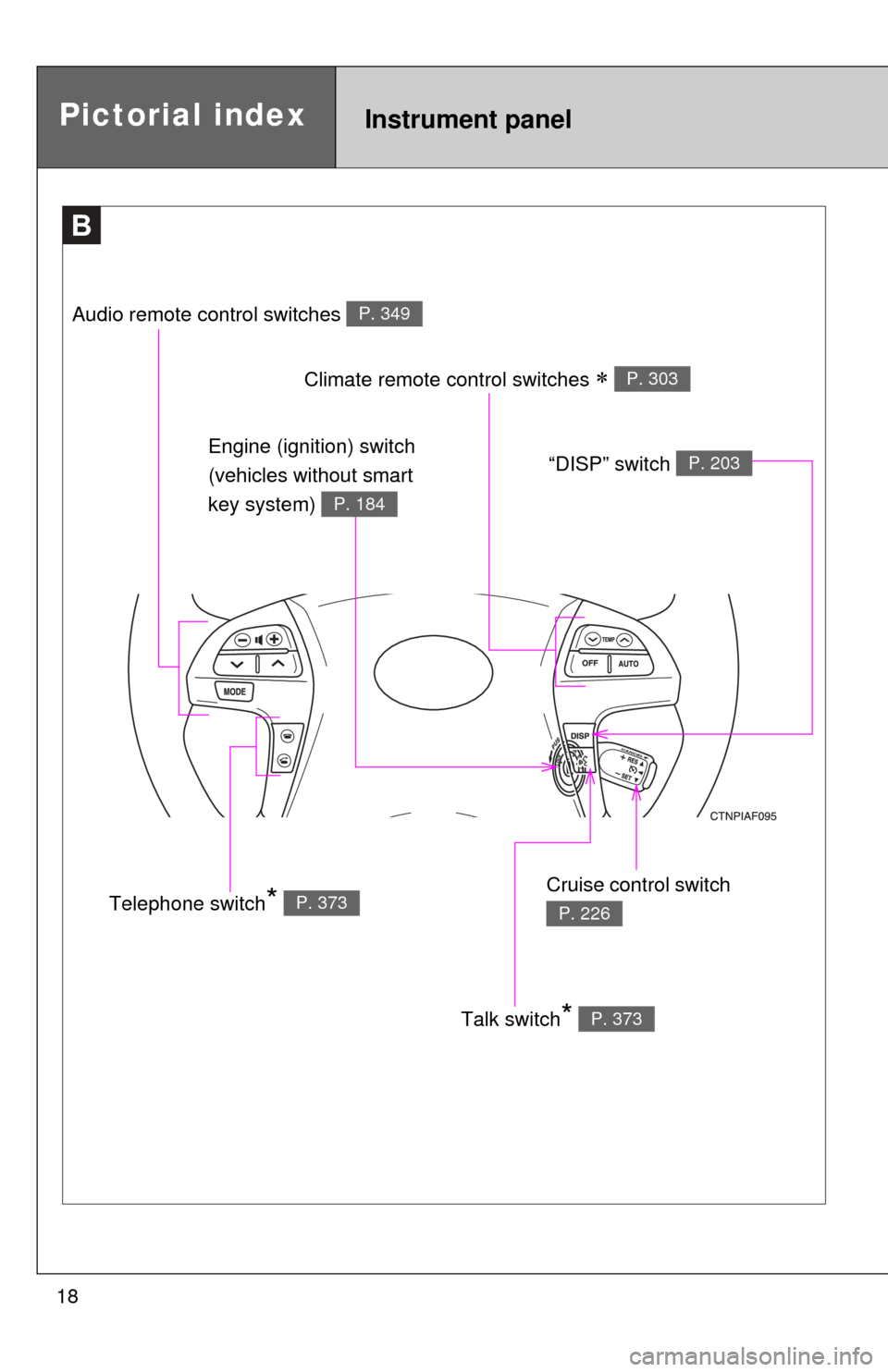
18
B
Talk switch* P. 373
Pictorial indexInstrument panel
Audio remote control switches P. 349
Climate remote control switches P. 303
Cruise control switch
P. 226Telephone switch* P. 373
Engine (ignition) switch
(vehicles without smart
key system)
P. 184
“DISP” switch P. 203
Page 25 of 636

25
Installation of a mobile two-way radio system
The installation of a mobile two-way radio system in your vehicle could affect
electronic systems such as:
●Multiport fuel injection system/sequential multiport fuel injection system
●Cruise control system
●Anti-lock brake system
●SRS airbag system
●Seat belt pretensioner system
Be sure to check with your Toyota dealer for precautionary measures or spe-
cial instructions regarding installation of a mobile two-way radio system.
High voltage parts and cables on the hybrid vehicles emit approximately the
same amount of electromagnetic waves as the conventional gasoline pow-
ered vehicles or home electronic appliances despite their electromagnetic
shielding.
Unwanted noise may occur in the reception of the mobile two-way radio.
Scrapping of your Toyota
The SRS airbag and seat belt pretensioner devices in your Toyota contain
explosive chemicals. If the vehicle is scrapped with the airbags and seat belt
pretensioners left as they are, this may cause an accident such as fire. Be
sure to have the systems of the SRS airbag and seat belt pretensioner
removed and disposed of by a qualified service shop or by your Toyota
dealer before you scrap your vehicle.
Perchlorate Material
Special handling may apply, See www.dtsc.ca.gov/hazardouswaste/perchlorate.
Your vehicle has components that may contain perchlorate. These compo-
nents may include airbag, seat belt pretensioners, and wireless remote con-
trol batteries.
Page 167 of 636
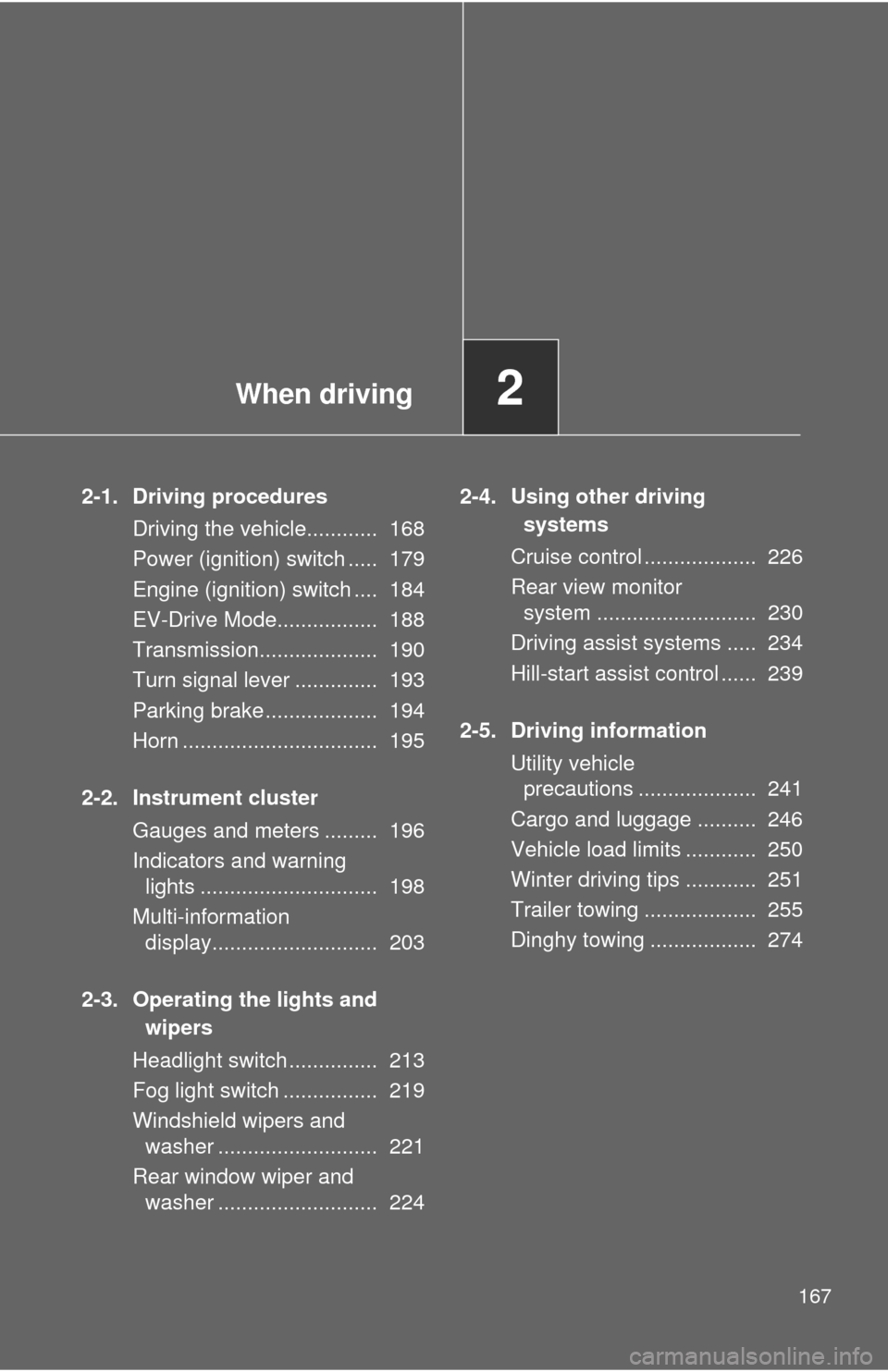
When driving2
167
2-1. Driving proceduresDriving the vehicle............ 168
Power (ignition) switch ..... 179
Engine (ignition) switch .... 184
EV-Drive Mode................. 188
Transmission.................... 190
Turn signal lever .............. 193
Parking brake ................... 194
Horn ................................. 195
2-2. Instrument cluster Gauges and meters ......... 196
Indicators and warning lights .............................. 198
Multi-information display............................ 203
2-3. Operating the lights and wipers
Headlight switch ............... 213
Fog light switch ................ 219
Windshield wipers and washer ........................... 221
Rear window wiper and washer ........................... 224 2-4. Using other driving
systems
Cruise control ................... 226
Rear view monitor system ........................... 230
Driving assist systems ..... 234
Hill-start assist control ...... 239
2-5. Driving information Utility vehicle precautions .................... 241
Cargo and luggage .......... 246
Vehicle load limits ............ 250
Winter driving tips ............ 251
Trailer towing ................... 255
Dinghy towing .................. 274
Page 200 of 636
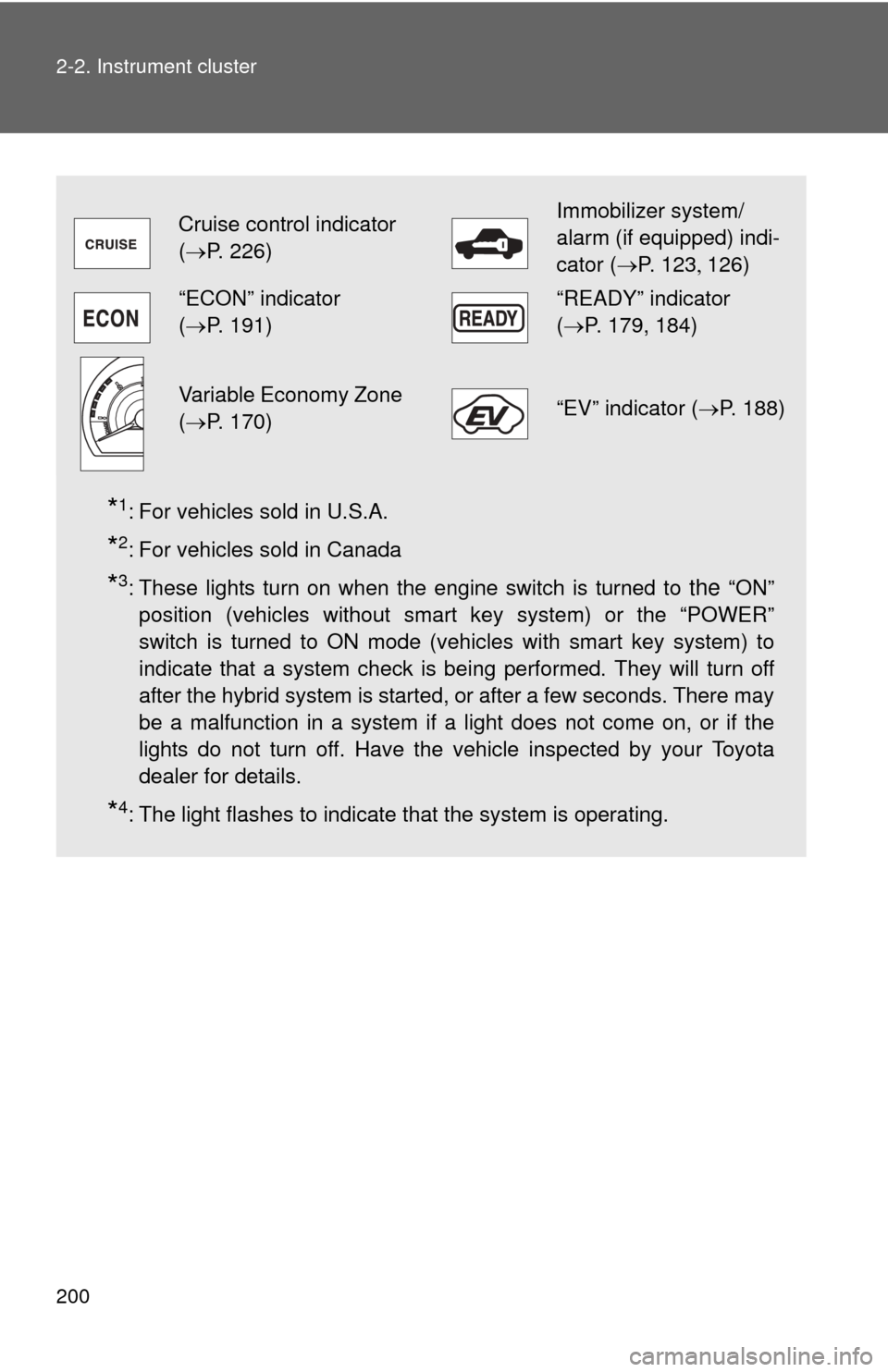
200 2-2. Instrument cluster
*1: For vehicles sold in U.S.A.
*2: For vehicles sold in Canada
*3: These lights turn on when the engine switch is turned to the “ON”
position (vehicles without smart key system) or the “POWER”
switch is turned to ON mode (vehicles with smart key system) to
indicate that a system check is being performed. They will turn off
after the hybrid system is started, or after a few seconds. There may
be a malfunction in a system if a light does not come on, or if the
lights do not turn off. Have the vehicle inspected by your Toyota
dealer for details.
*4: The light flashes to indicate that the system is operating.
Cruise control indicator
( P. 226)Immobilizer system/
alarm (if equipped) indi-
cator (P. 123 126)
“ECON” indicator
(P. 191)“READY” indicator
( P. 179, 184)
Variable Economy Zone
(P. 170)“EV” indicator ( P. 188)
Page 226 of 636
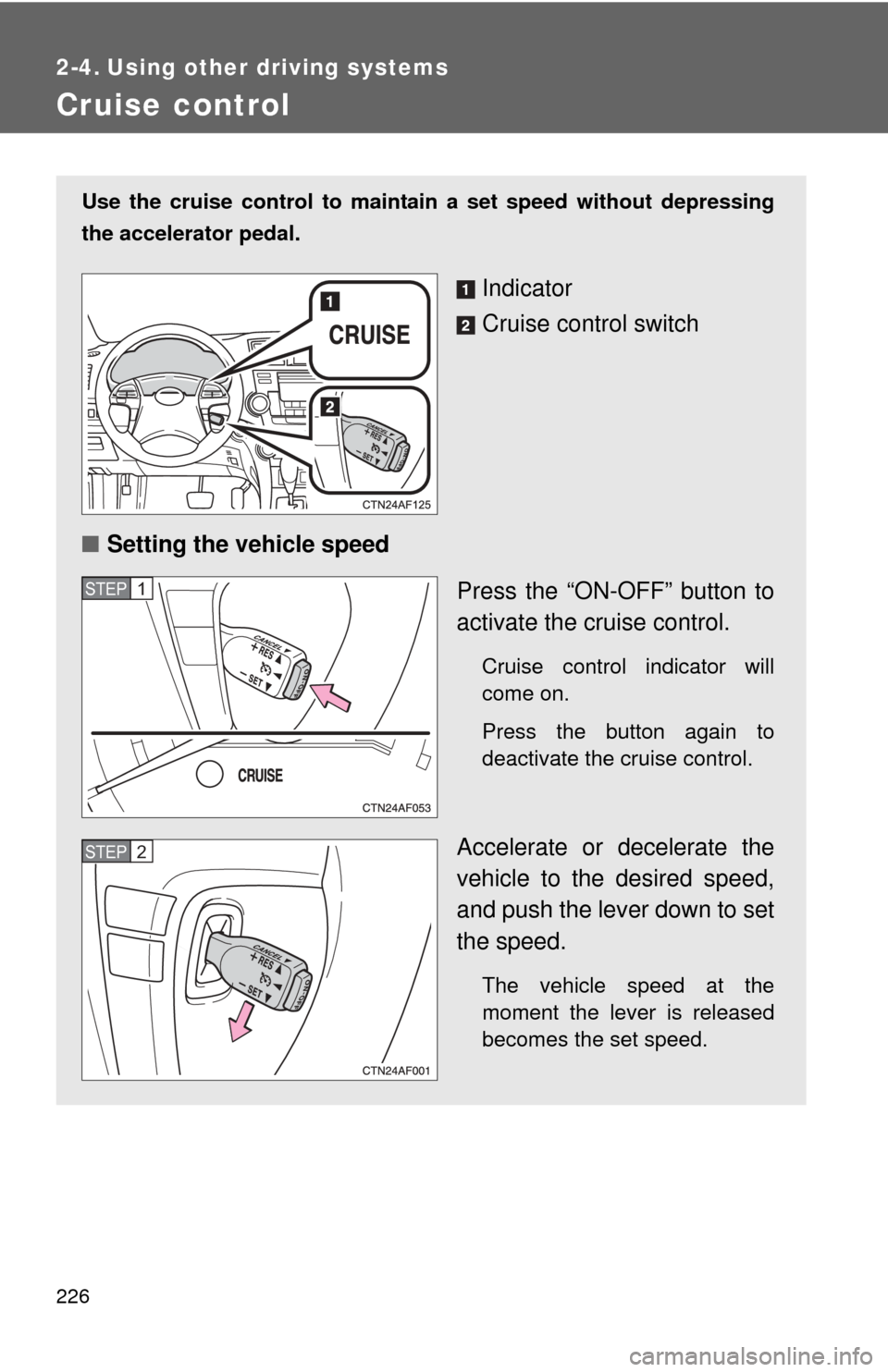
226
2-4. Using other driving systems
Cruise control
Use the cruise control to maintain a set speed without depressing
the accelerator pedal.
Indicator
Cruise control switch
■ Setting the vehicle speed
Press the “ON-OFF” button to
activate the cruise control.
Cruise control indicator will
come on.
Press the button again to
deactivate the cruise control.
Accelerate or decelerate the
vehicle to the desired speed,
and push the lever down to set
the speed.
The vehicle speed at the
moment the lever is released
becomes the set speed.
STEP1
STEP2
Page 228 of 636
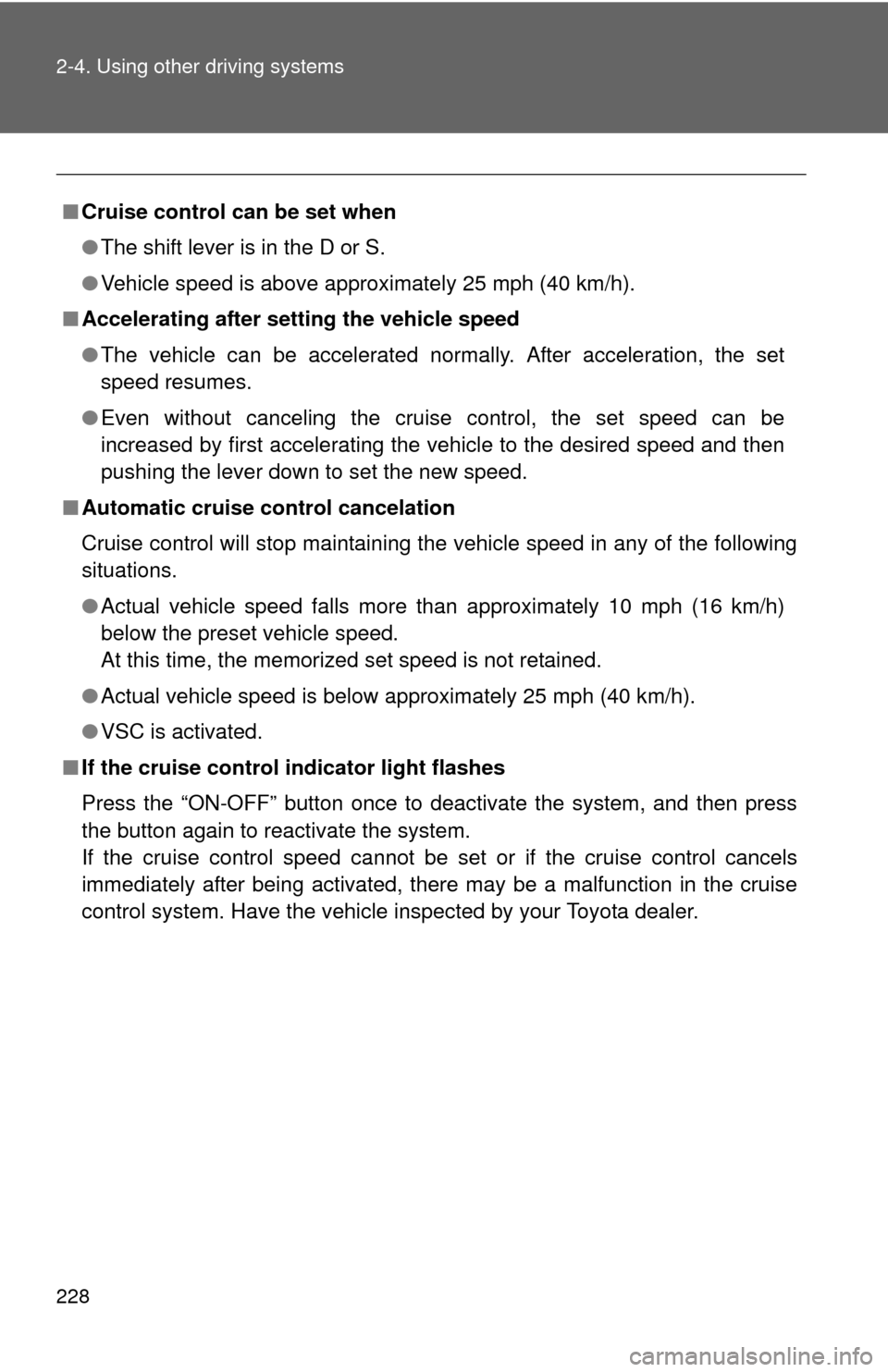
228 2-4. Using other driving systems
■Cruise control can be set when
●The shift lever is in the D or S.
● Vehicle speed is above approximately 25 mph (40 km/h).
■ Accelerating after setting the vehicle speed
●The vehicle can be accelerated normally. After acceleration, the set
speed resumes.
● Even without canceling the cruise control, the set speed can be
increased by first accelerating the vehicle to the desired speed and then
pushing the lever down to set the new speed.
■ Automatic cruise control cancelation
Cruise control will stop maintaining the vehicle speed in any of the following
situations.
●Actual vehicle speed falls more than approximately 10 mph (16 km/h)
below the preset vehicle speed.
At this time, the memorized set speed is not retained.
● Actual vehicle speed is below approximately 25 mph (40 km/h).
● VSC is activated.
■ If the cruise control indicator light flashes
Press the “ON-OFF” button once to deactivate the system, and then press
the button again to reactivate the system.
If the cruise control speed cannot be set or if the cruise control cancels
immediately after being activated, there may be a malfunction in the cruise
control system. Have the vehicle inspected by your Toyota dealer.
Page 229 of 636
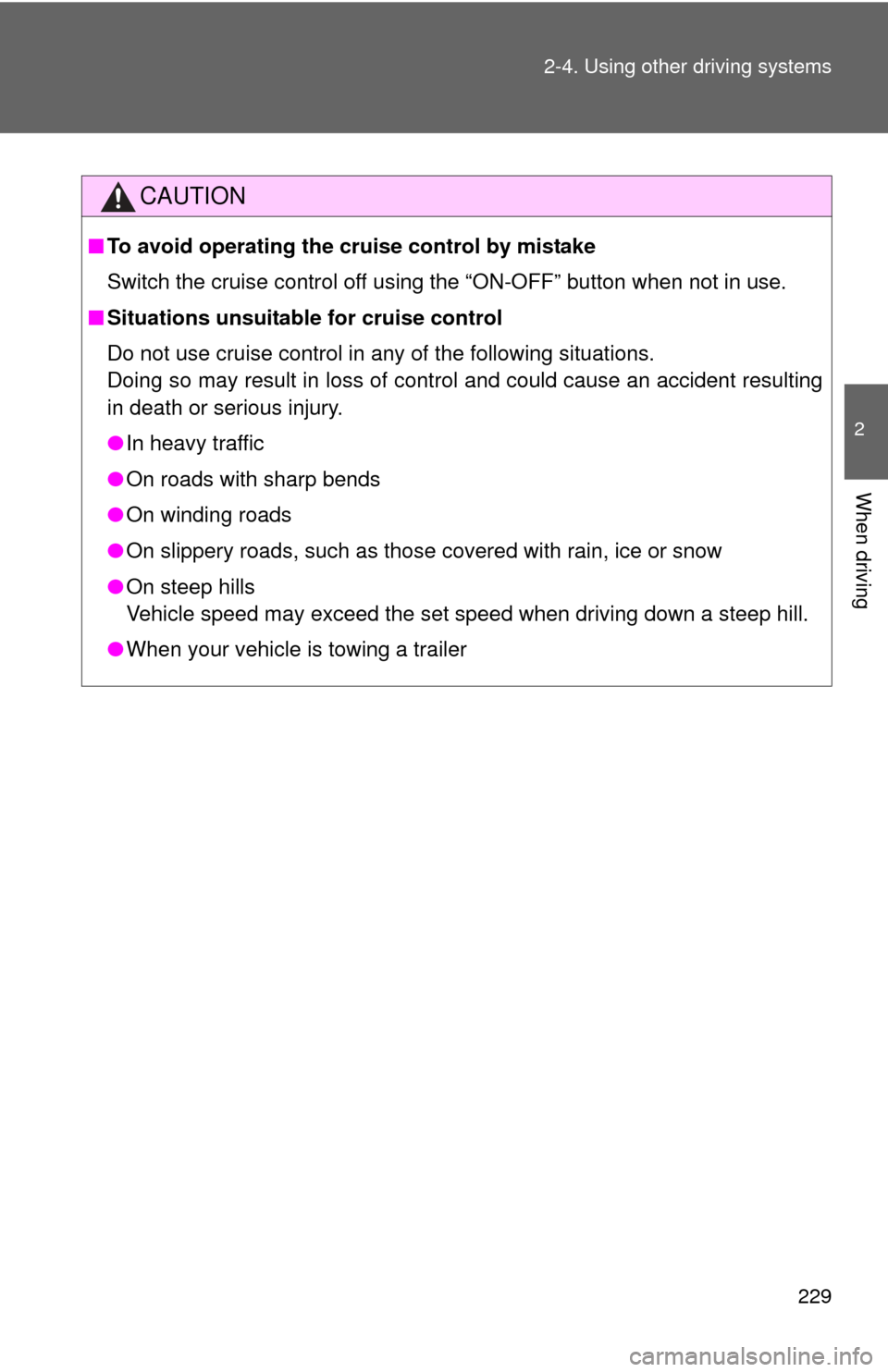
229
2-4. Using other
driving systems
2
When driving
CAUTION
■To avoid operating the cruise control by mistake
Switch the cruise control off using the “ON-OFF” button when not in use.
■ Situations unsuitable for cruise control
Do not use cruise control in any of the following situations.
Doing so may result in loss of control and could cause an accident resulting
in death or serious injury.
●In heavy traffic
● On roads with sharp bends
● On winding roads
● On slippery roads, such as those covered with rain, ice or snow
● On steep hills
Vehicle speed may exceed the set speed when driving down a steep hill.
● When your vehicle is towing a trailer
Page 271 of 636

271
2-5. Driving information
2
When driving
CAUTION
■
To avoid accident or injury
●Do not exceed the TWR, unbraked TWR, GCWR, GVWR or GAWR.
● If the gross trailer weight is over 2000 lb. (907 kg), a sway control device
with sufficient capacity is required.
● Adjust the tongue weight within the appropriate range. Place heavier loads
as close to the trailer axle as possible.
● Do not exceed 65 mph (104 km/h), the posted towing speed limit or the
speed limit for your trailer as set forth in your trailer owner’s manual,
whichever is lowest. Slow down sufficiently before making a turn, in cross
winds, on wet or slippery surface, etc. to help avoid an accident. If you
experience a vehicle-trailer instabilit y from reducing a certain speed, slow
down and make sure you keep your vehicle speed under the speed of
which you experience the instability.
● Do not make jerky, abrupt or sharp turns.
● Do not apply the brakes suddenly as you may skid, resulting in jackknifing
and loss of vehicle control. This is especially true on wet or slippery sur-
faces.
● Do not exceed the trailer hitch assembly weight, gross vehicle weight,
gross axle weight and trailer tongue weight capacities.
● Do not use cruise control when towing.
● Slow down and downshift before descending steep or long downhill
grades. Do not make sudden downshifts while descending steep or long
downhill grades.
● Vehicle-trailer instability is more likely on steep long downhills. Before
descending steep or long downhill grades, slow down and downshift. Do
not make sudden downshifts when descending steep or long downhill
grades. Avoid holding the brake pedal down too long or applying the
brakes too frequently. This could cause the brakes to overheat and result
in reduced braking efficiency.
Page 530 of 636
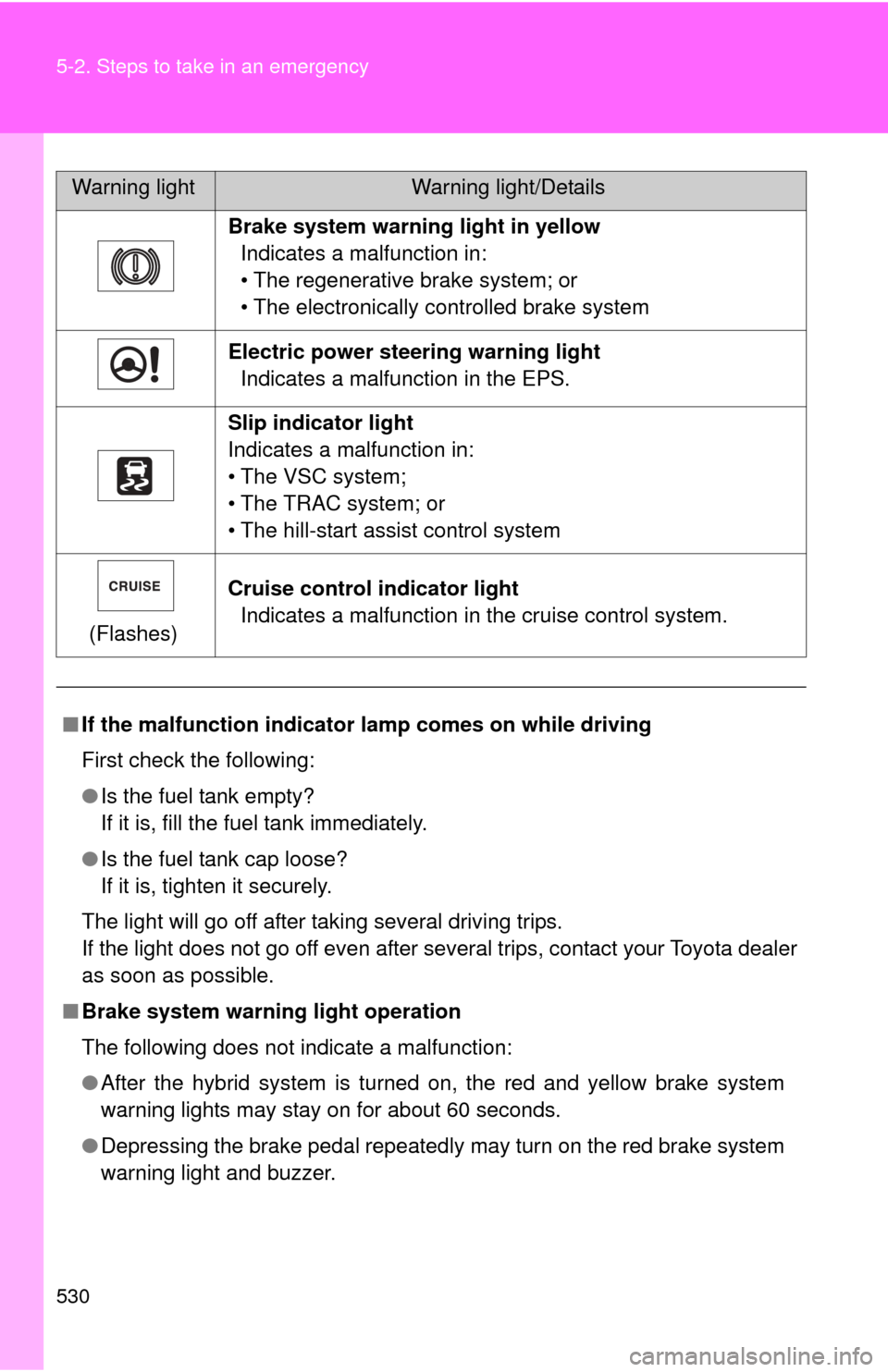
530 5-2. Steps to take in an emergency
Brake system warning light in yellowIndicates a malfunction in:
• The regenerative brake system; or
• The electronically controlled brake system
Electric power steering warning light Indicates a malfunction in the EPS.
Slip indicator light
Indicates a malfunction in:
• The VSC system;
• The TRAC system; or
• The hill-start assist control system
(Flashes) Cruise control indicator light
Indicates a malfunction in the cruise control system.
■ If the malfunction indicator lamp comes on while driving
First check the following:
● Is the fuel tank empty?
If it is, fill the fuel tank immediately.
● Is the fuel tank cap loose?
If it is, tighten it securely.
The light will go off after taking several driving trips.
If the light does not go off even after several trips, contact your Toyota dealer
as soon as possible.
■ Brake system warning light operation
The following does not indicate a malfunction:
●After the hybrid system is turned on, the red and yellow brake system
warning lights may stay on for about 60 seconds.
● Depressing the brake pedal repeatedly may turn on the red brake system
warning light and buzzer.
Warning lightWarning light/Details